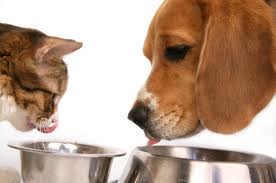Feeding Your Pet - Pet Food Choices
Pet Food Education

Pet Food Choices
There are many options to choose from when deciding which pet food you will feed your pet. Do you want your pet to dine on dry, wet, semi moist? Is holistic food or price of the pet food a consideration? Are you loyal to a specific manufacturer? Are you looking for a pet food product that will satisfy a special need for your active or senior pet, as an example? There are a myriad of pet food products that exist to satisfy the different needs of consumers and their pets.
Dry pet food is a nourishing choice for your dog and cat. It is reasonably priced, and offers a lot of benefits to your pet. The physical aspect of chewing dry dog food helps remove tartar from their teeth and enables your pet to “kind of brush his/her teeth” Dry food is often recommended by veterinarians for the proper development of puppies and young dogs jaws.
Dry pet food has many benefits for the pet owner and the pet. Dry food is easy to store, costs less to feed, is easier to measure in the right proportions, and stores well. Most dry pet food is produced by a machine called an extruder. After the ingredients are compiled and mixed together based on a recipe that counts the nutrient content of each food item. The dough mixtue is fed into the extruder which has precut shapes. The pressurized ingredients are pushed out of the extruder and cut by rapidly spinning knives into small pieces. As the dough cools, the individual pieces of pet food expand and puff into it the shape it will stay in. The pet food continues to dry and is usually sprayed with fat or other flavorings to make the food tasty. It is then put into bags and delivered to the pet food shelves where, we, the consumer purchase it and bring it home to our loving pets.
Pet Food Informatin

Ingredients in Pet Food
Some dog foods are baked at high temperatures of over 500 degrees, as an alternative to extrusion. Baked pet food does not usually need the added fat or other flavorings sprayed on. The crunch pieces are usually quite tasty as is to your pets.
Semi moist food is also made with an extruder and contains a multitude of chemicals to help the product maintain its shape and texture and make it appealing to the consumer. Semi moist food may not the best choice for your pet, due to the amount of preservatives, additives, and food coloring in this type of pet food
Canned food is another option of pet food choice. Canned or wet food is an excellent choice when pets cannot chew hard dry food. Wet food also helps dogs gain weight, and can settle issues dealing with digestion your pet may be having. Wet food is made with ingredients and additives, put into an extruder, and then cooked and canned. They undergo a special sterilization process at the manufacturer, and are then shipped to store shelves. Canned food often contains more protein than dry pet food, and may be of better quality. Wet pet food is usually made from “fresh” instead of processed ingredients. Wet food contains more moisture which makes this type of pet food good for cats to eat. Wet pet food is usually sold in cans or pouches.
By-products are often used in canned and dry pet foods of which the majority come from cattle and pigs. There is a wide variation in nutritional content when it comes to by-product ingredients, which are made from meat, poultry and fish leftovers not used in people food. Often dry pet foods include a significant amount of cereal grain and starchy vegetables to enhance texture of the product. These ingredients add high carbohydrate and high calories to the pet food. The dog and cat food that contains vegetable proteins are of lesser quality pet foods. Corn gluten is used in the majority of petfood to add “protein” in place of more costly animal based protein. It is important to be aware of the amount of vegetable proteins in the pet foods so that your pet achieves the maximum nutritional value from his/her diet.
Super premium, organic and natural selections of pet food don’t use by-products. When you are reading the ingredient label of the wet food, you will notice “turkey”, “lamb” or “beef “, as one of the first ingredients listed. Dogs and cats are carnivorous by nature, so it is important to consider feeding your dog and cat a meat based diet. Premium pet foods are better quality ingredients and have higher standards for their products. Usually they are not made with artificial food coloring, and include supplements such as antioxidants and vitamins. The way these pet foods are produced, make it easier for your pet to digest and add better nutritional valueWhat is Fortified Food for Your Dogs and Cats?
Low carbohydrate dog and food is pet food made from starchy vegetables such as potatoes and green peas. If your pet is allergic to grains, this type of food may help. Generally, dry, low carb pet food gives no benefits to a pet’s diet. In order to be tasty, these foods are high in fat and may cause your pet to gain weight. Canned varieties are often used for diabetic cats as a prevention and treatment program.
Most pet food is “fortified” to compensate for the lack of nutritious quality the dog and cat food is made with. Often vitamins and minerals are added to the food. Additionally, pet foods are made with preservatives to enable them to last through transportation and shipping and to have a long shelf life. There are 2 types of preservatives – natural and synthetic. Look for natural preservatives like Vitamin C (ascorbate), Vitamin E (mixed tocopherols), and oils of rosemary, clove, and other products that act as preservatives in the food.
If the ingredients include butylated hydroxyanisole (BHA) and butylated hydroxytoluene (BHT), propyl gallate, propylene glycol and ethoxyquin, it is made with synthetic preservatives.
There is a lot more to know about choosing the right pet food for your furry friend. You can read more in my other articles.









